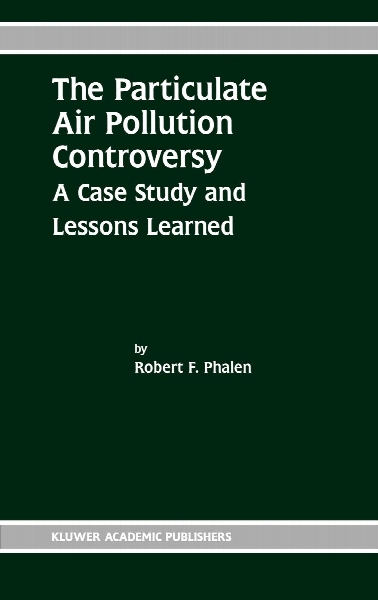The particulate air pollution controversy : a case study and lessons learned
- نوع فایل : کتاب
- زبان : انگلیسی
- مؤلف : Robert F Phalen; NetLibrary, Inc.
- ناشر : Boston : Kluwer Academic Publishers, cop
- چاپ و سال / کشور: 2002
- شابک / ISBN : 9780306482083
Description
NTS Preface Chapter 1. Harmful Effects of Particulate Air Pollution 1.1. 1.2. 1.3. 1.3.1. 1.3.2. 1.3.3. 1.3.4. Relevance to the Particulate Matter (PM) Controversy Breathing and Air Quality Early Indications of Health Effects of Urban Air Pollutants Emergence of Quantification of Particulate Matter The Three Great Air Pollution Disasters Early Epidemiology Studies Modern Epidemiology Studies 1.4. Lessons Learned xi 1 1 1 3 3 3 7 9 11 Chapter 2. Historical Overview 15 2.1. 2.2. 2.3. 2.4. 2.5. 2.6. 2.7. 2.8. 2.9. Relevance to the PM Controversy The Biology Problem Physical Factors Toxicology: the Science of Poisons Air Pollution from Antiquity Gas Warfare and Air Pollution Disasters A Regulatory History Modern Epidemiology Recent Events 2.9.1. 2.9.2. 2.9.3. New PM Regulations in the United States Legal Actions Media Coverage Lessons Learned 15 15 16 16 17 18 19 20 21 21 22 24 25 Chapter 3. Interpreting the PM Epidemiology 29 3.1. 3.2. 3.3. 3.4. 3.5. Relevance to the PM Controversy The Epidemiologic Associations Philosophical Challenges Challenges Based on the Size of the Associations Ecologic Study Issues 3.5.1. 3.5.2. 3.5.3. Chance Findings Bias Particulate Mass as a Surrogate 29 29 30 31 33 33 33 34 3.5.4. 3.5.5. To Whom Do the Associations Apply? Cause and Effect 3.6. Lessons Learned 34 35 35 Chapter 4. The Nature of Urban Particulate Matter 39 4.1. 4.2. 4.3. Relevance to the PM Controversy Defining PM Sources, Transport, and Composition of PM 4.3.1. 4.3.2. 4.3.3. Sources of PM Transport and Modeling of PM Composition of PM 4.4. 4.5. Indoor vs. Outdoor PM Particle Size Distributions 4.5.1. 4.5.2. Size-Distribution Basics Urban PM 4.6. 4.7. 4.8. 4.9. Episodes Long-Term Trends in PM Pollution Regional Differences in PM Major Uncertainties 39 39 40 40 41 42 44 45 45 46 46 49 50 50 4.10.Lessons Learned 51 Chapter 5. The Fates of Inhaled Particles 55 5.1. 5.2. 5.3. Relevance to the PM Controversy What Particles Are Actually Inhaled? Where Inhaled Particles Deposit 5.3.1. 5.3.2. 5.3.3. 5.3.4. 5.3.5. Anatomical Conventions Aerosol Considerations The MMAD Particle Deposition and Particle Size Species Differences 5.4. 5.5. 5.6. 5.7. Lessons Learned Particle Clearance Individual Differences Major Uncertainties 55 55 57 57 57 58 59 59 61 63 63 64 Chapter 6. The Toxicology of Particulate Material 69 6.1. 6.2. 6.3. Relevance to the PM Controversy Methods of Study Hypotheses for PM Toxicity 6.3.1. 6.3.2. 6.3.3. Mechanisms of Injury Particle Characteristics Other Explanations 69 69 70 70 71 72 viii 6.4. 6.5. 6.6. 6.7. Clinical Plausibility New Research Approaches 6.5.1. 6.5.2. Concentrated Air Pollutants Compromised Animal Models Major Uncertainties Lessons Learned 73 74 74 75 77 78 Chapter 7. Research Needs 81 7.1. 7.2. Relevance to the PM Controversy Colloquia on Particulate Air Pollution 7.2.1. 7.2.2. 7.2.3. First Colloquium (January 1994, Irvine, CA) Second Colloquium (May 1996, Park City, UT) Third Colloquium (June 1999, Durham, NC) 7.3. 7.4. The U.S. EPA Identifies Research Needs National Research Council (NRC) Recommendations 7.4.1. 7.4.2. The NRC Committee and Its Approach Highest-Priority Research Topics of the NRC 7.5. Other Efforts to Identify Research Needs 7.5.1. 7.5.2. The Clean Air Scientific Advisory Committee (CASAC) The Health Effects Institute (HEI) 7.6. 7.7. 7.8. Comparison of Research Planning Efforts Importance of the Research Planning Process Lessons Learned 81 81 81 83 84 84 86 86 86 89 89 90 91 92 93 Chapter 8. What’s at Stake? 95 8.1. 8.2. Relevance to the PM Controversy The Sources of PM and Associated Benefits 8.2.1. 8.2.2. Natural Processes Anthropogenic Activities 8.3. 8.4. 8.5. Consequences of Over- or Undercontrol of PM Major Uncertainties Lessons Learned 95 97 97 98 99 100 100 Chapter 9. Challenges to Dogma 103 9.1. 9.2. 9.3. 9.4. Relevance to the PM Controversy Challenging Current Dogma The Low-Dose Question The Small-Unit Risk, Large Population Dilemma 9.4.1. 9.4.2. 9.4.3. The Problem Examples Risk Tradeoffs 103 103 104 106 106 106 107 9.5. Stressors and Health 107 ix 9.5.1. 9.5.2. 9.5.3. What Are Stressors? Physiological Responses to Stress Adaptation 9.6. 9.7. 9.8. 9.9. Natural vs. Anthropogenic Pollutants Can the Most Sensitive Be Protected? Is Isolating Individual Contaminants Logical? Is the Most Recent Science Trustworthy? 9.10. Lessons Learned 107 107 108 109 110 112 112 113 Chapter 10. Conclusions and Recommendations 115 10.1. 10.2. Relevance to the PM Controversy What Is Known? 10.2.1. 10.2.2. 10.2.3. 10.2.4. The Epidemiological Associations The Complexity of PM Exposures The Role of Toxicology The Needed Research 10.3. What Is Unknown? 10.3.1. 10.3.2. 10.3.3. 10.3.4. 10.3.5. 10.3.6. 10.3.7. 10.3.8. Who, What, and How? The Metric Episode Chemistry Personal Exposures How Relevant Are Current Toxicology Models? What Are the Effects of PM Control Measures? How Serious Are the Tradeoffs? How Different Is Modern Air Pollution from Previous Air Pollution? 115 115 115 115 116 116 116 116 117 117 118 118 118 118 10.4. What Needs to Be Done? 10.4.1. 10.4.2. 10.4.3. 10.4.4. 10.4.5. By Researchers By Regulators By Legislators By the Public By Industry 119 119 119 120 120 121 121 122 122 122 123 123 10.5. Lessons Learned 10.5.1. 10.5.2. 10.5.3. Overview Time Scales for Change Public Health Is Complex 10.6. The Crossroad


